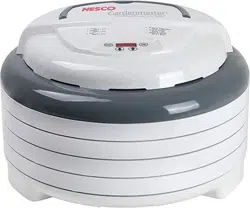Loading ...
Loading ...
Loading ...

12 13
Fruits picked at their prime have the
highest natural sugar content and the
best nutritional value. For the best
quality product, choose only fresh,
ripe unblemished fruits.
Fruits are ideal to dry because they
have a natural high sugar content.
They are high in acid (and
consequently less prone to spoilage
and micro-organisms), and taste
delicious! Seasonally, fruit can be
obtained in bulk from orchards or
farms for considerably lower prices
than you may find in the supermarket.
Selection
Preparation
Wash fruit thoroughly and remove
any imperfections.
Some fruits have a natural protective wax
coating such as figs, prunes, grapes,
blueberries, cranberries, etc. If the fruit has
been artificially waxed, it should be
peeled to remove the wax.
Remove skins (if desired), stems and seeds.
Halve or slice in ⁄” to ⁄” circles or slices.
1
2
3
If fruits are dried with the skins on, be sure
to place them skin-side down to prevent
fruit from dripping.
Dry at 135°F (57°C) and check frequently
near the end of the drying process and
remove pieces as they dry.
5
6
If you want to dry these fruits whole, dip
into boiling water for 1-2 minutes.This will
make the fruits’ skin more porous.
4
◆ Fruits are pliable and leathery with no spots of moisture. Tear in half,
pinch and watch for moisture drops along tear. If no moisture then it
is suciently dry for long term storage.
◆ Fruit rolls should be leathery with no sticky spots
◆ Jerky should be tough, but not brittle
◆ Dried fish should be tough, but not brittle. If the fish is high in fat it may
appear moist due to the high oil content.
◆ Vegetables should be tough or crisp
If foods are insuciently dried, or are exposed to moisture from faulty
packaging, they can lose quality and nutrition, and can even mold
during storage.
Labeling and Record Keeping
All dehydrated foods should be labeled with the name of the product, date dried
and quantity or weight. Clear labeling allows you to rotate foods to minimize
waste and nutrient loss. Record the date dried, quantity, weight before and
after, drying time, size of containers, storage temperature and length of time
before use.
Storage
The storage area should be cool, dry and as dark as possible. The darker and
cooler the storage area, the longer the dried foods will last with good quality
and nutritive value.
The ideal storage temperature for dehydrated foods is 60°F (15°C) to below
freezing. The ideal storage place is your freezer or refrigerator, particularly for
storing low acid foods such as meats, fish and vegetables.
Pre-Treatment
Pre-treatment minimizes oxidation, and gives you a superior quality, better
tasting product with less vitamin loss. Apples, pears, peaches, and apricots are
better when pre-treated. They are more appetizing, have a longer shelf life and
higher nutritional value. Place cut fruits that tend to brown in a holding solution
of ascorbic acid to reduce browning during preparation. Do not keep cut fruit in
a holding solution for more than one hour.
Pre-treatment can vary from soaking in fruit juice, ascorbic acid mixtures, syrup
blanching, steaming, to sulfating. The results of these methods also vary.
Experiment and decide for yourself which one you like best.
Loading ...
Loading ...
Loading ...
